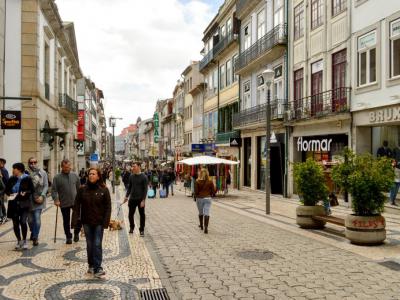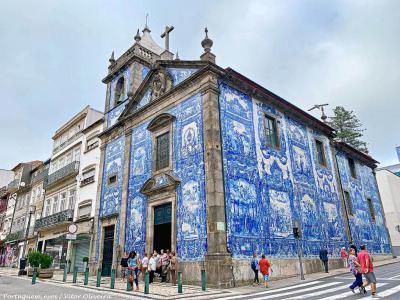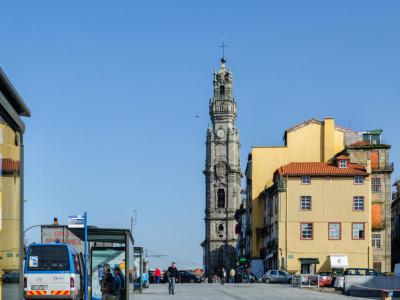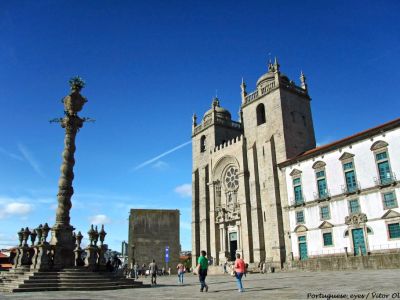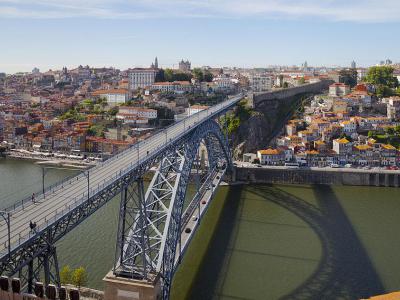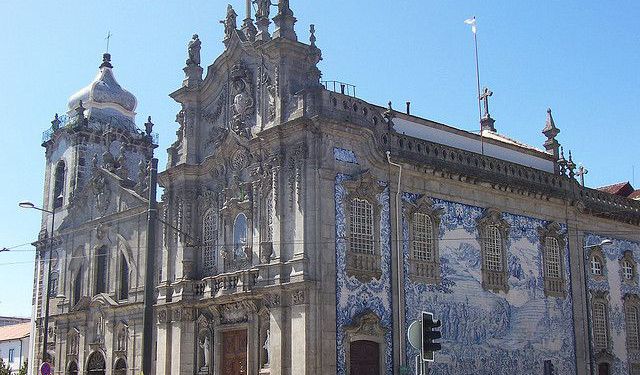
Porto Introduction Walking Tour (Self Guided), Porto
After 711 Porto fell to Moorish invaders. The Muslim control existed in the Iberian peninsula until 1491. However, the conquest was not total and in 868 things began to change for the people of Porto.
Vimara Peres, an Asturian count of Gallaecia, came to reconquer for the Christians. He secured the town of Portu Cale and the land of Vila Nova de Gaia. Vimara became the Count of Portucale. From Portucale eventually came the name Portugal.
Fast forward to 1387. King John I of Portugal marries Philippa of Lancaster. The marriage cemented the new alliance between England and Portugal. The alliance is memorialized in Porto's grand boulevard, Avenue of the Allies.
Fast forward again. In 1812 French troops under Marshal Soult attacked the city. Thousands of citizens drowned in the River Douro as they tried to flee. The invaders were uprooted in turn by Arthur Wellesley, Duke of Wellington, using wine barges of troops to outflank the French.
Things are much calmer these days. Cross over the steel double-decker Dom Luis Bridge from Porto to Vila Nova de Gaia for some wine. Take a cable car ride to Serra Pilar Viewpoint. Ride the funicular from Ribera up to Batalha. See the Stock Exchange Palace's Arabian Room.
Visit the Fortress-like Porto Cathedral. The Gothic, Baroque and Romanesque Cathedral was the venue for the marriage of John and Philippa. See the Church of Souls. Enjoy the sumptuous and welcoming Cafe Majestic on the Avenue of the Allies.
Historic Porto has more, old and new, patiently waiting. Climb the Tower of the Clergymen. See it all at sunset.
Vimara Peres, an Asturian count of Gallaecia, came to reconquer for the Christians. He secured the town of Portu Cale and the land of Vila Nova de Gaia. Vimara became the Count of Portucale. From Portucale eventually came the name Portugal.
Fast forward to 1387. King John I of Portugal marries Philippa of Lancaster. The marriage cemented the new alliance between England and Portugal. The alliance is memorialized in Porto's grand boulevard, Avenue of the Allies.
Fast forward again. In 1812 French troops under Marshal Soult attacked the city. Thousands of citizens drowned in the River Douro as they tried to flee. The invaders were uprooted in turn by Arthur Wellesley, Duke of Wellington, using wine barges of troops to outflank the French.
Things are much calmer these days. Cross over the steel double-decker Dom Luis Bridge from Porto to Vila Nova de Gaia for some wine. Take a cable car ride to Serra Pilar Viewpoint. Ride the funicular from Ribera up to Batalha. See the Stock Exchange Palace's Arabian Room.
Visit the Fortress-like Porto Cathedral. The Gothic, Baroque and Romanesque Cathedral was the venue for the marriage of John and Philippa. See the Church of Souls. Enjoy the sumptuous and welcoming Cafe Majestic on the Avenue of the Allies.
Historic Porto has more, old and new, patiently waiting. Climb the Tower of the Clergymen. See it all at sunset.
How it works: Download the app "GPSmyCity: Walks in 1K+ Cities" from Apple App Store or Google Play Store to your mobile phone or tablet. The app turns your mobile device into a personal tour guide and its built-in GPS navigation functions guide you from one tour stop to next. The app works offline, so no data plan is needed when traveling abroad.
Porto Introduction Walking Tour Map
Guide Name: Porto Introduction Walking Tour
Guide Location: Portugal » Porto (See other walking tours in Porto)
Guide Type: Self-guided Walking Tour (Sightseeing)
# of Attractions: 8
Tour Duration: 2 Hour(s)
Travel Distance: 3.2 Km or 2 Miles
Author: ChristineS
Sight(s) Featured in This Guide:
Guide Location: Portugal » Porto (See other walking tours in Porto)
Guide Type: Self-guided Walking Tour (Sightseeing)
# of Attractions: 8
Tour Duration: 2 Hour(s)
Travel Distance: 3.2 Km or 2 Miles
Author: ChristineS
Sight(s) Featured in This Guide:
- Rua Santa Catarina (St. Catherine Street)
- Capela das Almas (Chapel of Souls)
- Café Majestic
- Praça da Liberdade (Liberty Square)
- Church and Tower of the Clergymen
- Sé Catedral do Porto (Porto Cathedral)
- Ponte de Dom Luís I (Luís I Bridge)
- Serra do Pilar Monastery and Viewpoint
1) Rua Santa Catarina (St. Catherine Street) (must see)
St Catherine Street is Porto's main shopping thoroughfare. It is totally pedestrianized and it extends from Marques de Pombal Park in the north to Batalha Park in the south. It runs between buildings with Art Deco facades. It is named for the Chapel of Souls and St Catherine of Alexandria.
Shop on Marques de Pombal for clothing, haberdashery goods, and shoes. The Via Catarina shopping center, many street vendors, and cafes make for a busy day for visitors.
Landmarks encountered are the Latina New Art Bookstore at Batalha Park and Palladium Gallery at the intersection of Passos Manuel Street. The Cafe Majestic, since 1921 a watering hole for Porto's intelligencia, is next to the Imperiel Tea Room, also a historic landmark.
The prestigious Porto Grand Hotel is next, since 1880 a haven for the famous. It was a place to die in 1889 for Teresa Cristina, Empress of Brazil. Prime Minister Afonso Costa was held prisoner here in 1917 during a coup d'etat.
At last, there is the Chapel of Santa Catarina also known as Chapel of Souls on the corner of Fernandes Tomas Street.
Shop on Marques de Pombal for clothing, haberdashery goods, and shoes. The Via Catarina shopping center, many street vendors, and cafes make for a busy day for visitors.
Landmarks encountered are the Latina New Art Bookstore at Batalha Park and Palladium Gallery at the intersection of Passos Manuel Street. The Cafe Majestic, since 1921 a watering hole for Porto's intelligencia, is next to the Imperiel Tea Room, also a historic landmark.
The prestigious Porto Grand Hotel is next, since 1880 a haven for the famous. It was a place to die in 1889 for Teresa Cristina, Empress of Brazil. Prime Minister Afonso Costa was held prisoner here in 1917 during a coup d'etat.
At last, there is the Chapel of Santa Catarina also known as Chapel of Souls on the corner of Fernandes Tomas Street.
2) Capela das Almas (Chapel of Souls) (must see)
At the end of the eighteenth century the Brotherhood of Souls moved from the Monastery of Santa Clara to the chapel of Santa Catarina. The addition of the Brotherhood swelled the size of the Santa Catarina faction of devotees to the point where a new building was needed. The chapel therefore was expanded and restored in 1801.
The facade has a framed door under a circular pediment. A coat of arms is set on the tympanum showing St Francis of Assisi and Santa Catarina. The bell tower has two floors. On the first floor is a door with a window. The second floor has four windows and a balcony. Atop the dome is an iron cross.
The style of the church is basically neoclassical, but the church is noted for its covering of azulejo tiles. The tiles were made at the Viuva Lamego Ceramic Workshop in Lisbon. The 16,000 glowing blue and white tiles depict scenes from the lives of Saint Catherine and Saint Francis of Assisi.
The stained glass windows, made by Amandio Silva, show the souls in Purgatory washed with the redeeming blood of Christ. Inside the chapel is the 18th century image, Virgin of Souls. On the main altar is the large painting called "The Ascension of the Lord" by Joaquin Rafael, a professor of Fine Arts in Lisbon.
This is without a doubt, the most beautiful church in Porto. It must not be overlooked.
The facade has a framed door under a circular pediment. A coat of arms is set on the tympanum showing St Francis of Assisi and Santa Catarina. The bell tower has two floors. On the first floor is a door with a window. The second floor has four windows and a balcony. Atop the dome is an iron cross.
The style of the church is basically neoclassical, but the church is noted for its covering of azulejo tiles. The tiles were made at the Viuva Lamego Ceramic Workshop in Lisbon. The 16,000 glowing blue and white tiles depict scenes from the lives of Saint Catherine and Saint Francis of Assisi.
The stained glass windows, made by Amandio Silva, show the souls in Purgatory washed with the redeeming blood of Christ. Inside the chapel is the 18th century image, Virgin of Souls. On the main altar is the large painting called "The Ascension of the Lord" by Joaquin Rafael, a professor of Fine Arts in Lisbon.
This is without a doubt, the most beautiful church in Porto. It must not be overlooked.
3) Café Majestic
It was 1921. Aviator Gago Coutinho had just flown in from the island of Madeira. He dropped in for a drink at the new Art Nouveau Cafe "Elite." He found himself in a chic crowd of artists and celebrities. They were observing the grand opening of the cafe. He became enchanted at the lavish splendor of the decor.
Later, the name of the cafe was changed to "Majestic." Everyone approved. The Majestic became a haunt for students and teachers from the Porto School of Fine Arts. Gago was impressed by gatherings that included the sculptor Jose Rodrigues, the philosopher Leonardo Coimbra, the painters Armando Alves, Angelo de Sousa and Jorge Pinheiro.
More recently, the Majestic book of honor has been signed by others, among them Mario Soares, Jorge Sampaio, Jaques Chirac and Cavaco Silva. Today the cafe continues on with poetry readings, concerts, exhibitions and performances. It is said author J.K. Rowling spent afternoons at the Majestic writing Harry Potter and the Philosopher's Stone.
Outside, the marble facade, decked out with twisting floral shapes and three graceful columns, invites travelers to enter. Inside, curved wooden frames and decorations capture attention. Stucco faces and nude figures emphasize sensuality.
Later, the name of the cafe was changed to "Majestic." Everyone approved. The Majestic became a haunt for students and teachers from the Porto School of Fine Arts. Gago was impressed by gatherings that included the sculptor Jose Rodrigues, the philosopher Leonardo Coimbra, the painters Armando Alves, Angelo de Sousa and Jorge Pinheiro.
More recently, the Majestic book of honor has been signed by others, among them Mario Soares, Jorge Sampaio, Jaques Chirac and Cavaco Silva. Today the cafe continues on with poetry readings, concerts, exhibitions and performances. It is said author J.K. Rowling spent afternoons at the Majestic writing Harry Potter and the Philosopher's Stone.
Outside, the marble facade, decked out with twisting floral shapes and three graceful columns, invites travelers to enter. Inside, curved wooden frames and decorations capture attention. Stucco faces and nude figures emphasize sensuality.
4) Praça da Liberdade (Liberty Square) (must see)
In the lower town or Baixa district of Porto, on the south side of the Avenue of the Allies, lies Liberty Square. This is a largish area of more than three square miles. Originally called New Square, Liberty Square is a product of the 1718 urbanization movement of Porto.
In 1788 the religious order of Saint Eligius, Patron Saint of veterinarians, horses, goldsmiths and blacksmiths, built a convent on the south edge of the square. They demolished part of the medieval wall of the city, replacing it with the convent, an impressive neoclassical building, still standing as the Cardosas Palace.
In 1866 a monument honoring King Peter IV was erected in the square. Peter IV was not only King of Portugal as Peter IV, he was also Emperor of Brazil as Peter I.
As each of the two Peters, he fought to preserve the liberal constitution in Portugal and liberty in Brazil. His monument, designed by sculptor Anatole Calmels, is a statue of Peter IV mounted and holding the constitution he had fought for in the Liberal Wars.
The square underwent a change in 1916 when the modern Avenue of the Allies was pushed through to the north of the square. The buildings around the square today are banks, hotels, offices and restaurants. The monument to Peter IV dominates the huge square. Other notable sights would include the Bank of Portugal and the Cardosas Palace.
In 1788 the religious order of Saint Eligius, Patron Saint of veterinarians, horses, goldsmiths and blacksmiths, built a convent on the south edge of the square. They demolished part of the medieval wall of the city, replacing it with the convent, an impressive neoclassical building, still standing as the Cardosas Palace.
In 1866 a monument honoring King Peter IV was erected in the square. Peter IV was not only King of Portugal as Peter IV, he was also Emperor of Brazil as Peter I.
As each of the two Peters, he fought to preserve the liberal constitution in Portugal and liberty in Brazil. His monument, designed by sculptor Anatole Calmels, is a statue of Peter IV mounted and holding the constitution he had fought for in the Liberal Wars.
The square underwent a change in 1916 when the modern Avenue of the Allies was pushed through to the north of the square. The buildings around the square today are banks, hotels, offices and restaurants. The monument to Peter IV dominates the huge square. Other notable sights would include the Bank of Portugal and the Cardosas Palace.
5) Church and Tower of the Clergymen (must see)
Nicolau Nasoni, an Italian architect and painter of the 18th century, did a lot of work throughout Portugal. His most memorable project is the Church and Tower of the Clergymen. His other works include the construction of the Misericordia Church, the Archbishop's Palace and the lateral loggia of Porto Cathedral.
Construction of the church was completed in 1750. The bell tower and divided staircase in front of the church were not finished until 1763. The facade is ornate with Baroque decorations such as garlands and shells and an indented pediment. The frieze above the windows has spiritual symbols. The sides show an elliptical nave.
The Church of the Clergymen (Clerigos) was among the first baroque style churches to have an elliptical floorplan. The polychromed marble altarpiece in the large chapel was done by Manuel dos Santos Porto.
The Tower is in a Roman Baroque style of Tuscan bell towers. It is 245 feet high and it takes 240 steps to reach the top for an incredible view of Porto. The tower is one of the recognizable symbols of Porto.
Nicolau entered the Clerigos Brotherhood and when he died he was buried in the crypt of his masterpiece, The Church and Tower of the Clergymen.
Construction of the church was completed in 1750. The bell tower and divided staircase in front of the church were not finished until 1763. The facade is ornate with Baroque decorations such as garlands and shells and an indented pediment. The frieze above the windows has spiritual symbols. The sides show an elliptical nave.
The Church of the Clergymen (Clerigos) was among the first baroque style churches to have an elliptical floorplan. The polychromed marble altarpiece in the large chapel was done by Manuel dos Santos Porto.
The Tower is in a Roman Baroque style of Tuscan bell towers. It is 245 feet high and it takes 240 steps to reach the top for an incredible view of Porto. The tower is one of the recognizable symbols of Porto.
Nicolau entered the Clerigos Brotherhood and when he died he was buried in the crypt of his masterpiece, The Church and Tower of the Clergymen.
6) Sé Catedral do Porto (Porto Cathedral) (must see)
In 868, Vimara Peres, an Asturias nobleman born in 820, conquered Moorish held lands north of the river Douro. One of the towns he took went by the name Portus Cale. Portus Cale became Portucale, the county he would rule. The town became Porto. Penaventosa, the highest hill in Portus Cale, became the site of Porto Cathedral.
The hill was once the location of a Suebian Church. Work began on the Cathedral in the 12th century. There were fits and starts over the years, but the building was finally considered complete in 1737. It is the most impressive Romanesque style edifice in Porto. On top of Penaventosa it sits, fortress-like, overlooking the town.
The cathedral is flanked by twin square towers. Each tower is buttressed and topped with a cupola. The western façade has 15th century Gothic ornamentation. There is also an impressive Gothic cloister installed in 1736 by Nicolau Nasoni, an architect from Tuscany who settled in Portugal.
On the northern side of the cathedral is a baroque porch and a Romanesque rose window under a crenelated arch. The crenellations reinforce the impression of a fortress. The nave is not wide. It is covered with a barrel vault.
The baroque apse is decorated with paintings by Nasoni. The altarpiece of the chapel was designed by Santos Pacheco. The south transept is decorated with blue azulejo tiles.
Mass is celebrated every day at 11am.
Why You Should Visit:
You wouldn't want to miss the city's oldest and most visited monument! The square also offers impressive views over the city, the Douro River and the wine cellars on the waterfront.
Tip:
While admission to the Porto Cathedral is free, there's a small fee to get into the Sacred Art Museum and the magnificent Gothic cloisters attached to the church. If you're feeling fit you can also climb the tower (steps are steep and numerous!) for amazing views, including at the bits of the cathedral you can't see from further down.
The hill was once the location of a Suebian Church. Work began on the Cathedral in the 12th century. There were fits and starts over the years, but the building was finally considered complete in 1737. It is the most impressive Romanesque style edifice in Porto. On top of Penaventosa it sits, fortress-like, overlooking the town.
The cathedral is flanked by twin square towers. Each tower is buttressed and topped with a cupola. The western façade has 15th century Gothic ornamentation. There is also an impressive Gothic cloister installed in 1736 by Nicolau Nasoni, an architect from Tuscany who settled in Portugal.
On the northern side of the cathedral is a baroque porch and a Romanesque rose window under a crenelated arch. The crenellations reinforce the impression of a fortress. The nave is not wide. It is covered with a barrel vault.
The baroque apse is decorated with paintings by Nasoni. The altarpiece of the chapel was designed by Santos Pacheco. The south transept is decorated with blue azulejo tiles.
Mass is celebrated every day at 11am.
Why You Should Visit:
You wouldn't want to miss the city's oldest and most visited monument! The square also offers impressive views over the city, the Douro River and the wine cellars on the waterfront.
Tip:
While admission to the Porto Cathedral is free, there's a small fee to get into the Sacred Art Museum and the magnificent Gothic cloisters attached to the church. If you're feeling fit you can also climb the tower (steps are steep and numerous!) for amazing views, including at the bits of the cathedral you can't see from further down.
7) Ponte de Dom Luís I (Luís I Bridge) (must see)
The banks of the River Douro are granite. Spanning the river in two different locations less than a mile apart are the bridges of Luis I, King of Portugal and his royal bride, D. Maria Pia. The bridge of Luis looks remarkably similar to that of Maria. Both bridges have enormous iron webs and arches supporting transit over the river.
The reason they look alike is simple. The D. Maria Pia bridge was designed by Gustave Eiffel, famous for his tower in Paris. The Dom Luis bridge was designed by Teophile Seyrig. Seyrig had partnered with Eiffel on the D. Maria Pia bridge and the Eiffel Tower. The span of the Luis Bridge is 564 feet and the height is 146 feet.
A novel feature of the Luis I bridge is its two levels. One passes over the the highest point of the arch and the other hangs beneath the arch. Originally, both levels were meant for road traffic. However, today the top level carries trains of the Metro alongside pedestrian walkways. Walking on the upper level is a thrill not to be missed.
From the upper level there are matchless views of Porto Cathedral and the Tower of the Clergymen dominating the skyline of old Porto.
Why You Should Visit:
Visit the upper level for the thrill, the view and bragging rights. It may not be the only bridge in town but it's the best.
The reason they look alike is simple. The D. Maria Pia bridge was designed by Gustave Eiffel, famous for his tower in Paris. The Dom Luis bridge was designed by Teophile Seyrig. Seyrig had partnered with Eiffel on the D. Maria Pia bridge and the Eiffel Tower. The span of the Luis Bridge is 564 feet and the height is 146 feet.
A novel feature of the Luis I bridge is its two levels. One passes over the the highest point of the arch and the other hangs beneath the arch. Originally, both levels were meant for road traffic. However, today the top level carries trains of the Metro alongside pedestrian walkways. Walking on the upper level is a thrill not to be missed.
From the upper level there are matchless views of Porto Cathedral and the Tower of the Clergymen dominating the skyline of old Porto.
Why You Should Visit:
Visit the upper level for the thrill, the view and bragging rights. It may not be the only bridge in town but it's the best.
8) Serra do Pilar Monastery and Viewpoint
Designated a UNESCO World Heritage Site in 1996, the Monastery is in Vila Nova de Gaia, on the opposite side of the Douro River from Porto. The Monastery perches on a high outcrop above the Luis I Bridge and the center of the city. It can be reached by public transport using the Porto Metro's D line to the Garden do Morro Station.
The monks of Grijo of the Dominican Order needed more room. The Monastery in Grijo was becoming dilapidated. A new monastery with cloisters was finished in 1583. But wouldn't you know it, it was too small. More room for monks was needed. The new, present day Serra do Pilar Monastery was completed at last by 1700.
The Monastery was an important military outpost for General Arthur Wellesley, Duke of Wellington in the Peninsular War. It was a Liberal strong point during the civil war in 1833. The monastery was fortified in the 19th century and continued to be used by the military. In 1910 the site became a National Monument of Portugal.
The church and cloister are both circular, separated by a rectangular choir and chapel. On the north side is the bell tower and dormitories. The south side holds the sacristy and refectory.
There is a small fee to enter the church. A guided tour goes up to the dome of the tower, offering a stunning, extraordinary view of the Douro and the city of Porto.
The monks of Grijo of the Dominican Order needed more room. The Monastery in Grijo was becoming dilapidated. A new monastery with cloisters was finished in 1583. But wouldn't you know it, it was too small. More room for monks was needed. The new, present day Serra do Pilar Monastery was completed at last by 1700.
The Monastery was an important military outpost for General Arthur Wellesley, Duke of Wellington in the Peninsular War. It was a Liberal strong point during the civil war in 1833. The monastery was fortified in the 19th century and continued to be used by the military. In 1910 the site became a National Monument of Portugal.
The church and cloister are both circular, separated by a rectangular choir and chapel. On the north side is the bell tower and dormitories. The south side holds the sacristy and refectory.
There is a small fee to enter the church. A guided tour goes up to the dome of the tower, offering a stunning, extraordinary view of the Douro and the city of Porto.
Walking Tours in Porto, Portugal
Create Your Own Walk in Porto
Creating your own self-guided walk in Porto is easy and fun. Choose the city attractions that you want to see and a walk route map will be created just for you. You can even set your hotel as the start point of the walk.
Porto's Monuments and Statues
In general, just like any other European nation, sunny Portugal is rich in history and matching love of monuments. This is more so evident in the country's second largest city of Porto, dotted with statues and sculptures of various sort, decorating the gardens, sidewalks, squares and various corners. Each of them has its own story; some are quite old, while others are not so much and rather... view more
Tour Duration: 1 Hour(s)
Travel Distance: 2.1 Km or 1.3 Miles
Tour Duration: 1 Hour(s)
Travel Distance: 2.1 Km or 1.3 Miles
Porto Historic Center Walking Tour
The Historic Centre of Porto, dating back to the Medieval times, is the oldest part of the city and a UNESCO World Heritage Site since 1996. Despite all the changes over the years, it has maintained the unique urban characteristics, which are a world apart from other European cities, and preserved much of its legacy from the times gone by.
Firmly set on the hillsides overlooking the mouth of... view more
Tour Duration: 2 Hour(s)
Travel Distance: 2.6 Km or 1.6 Miles
Firmly set on the hillsides overlooking the mouth of... view more
Tour Duration: 2 Hour(s)
Travel Distance: 2.6 Km or 1.6 Miles
Historical Churches
Portugal is one of the oldest countries in Europe and is deeply rooted in Christianity, notably Catholicism. The latter explains the abundance of historic chapels, churches, and monasteries in the country. Porto, a city with a rich historical and cultural heritage, boasts several old churches of its own. Remarkable architectural gems, they reflect the city's profound religious tradition.
... view more
Tour Duration: 2 Hour(s)
Travel Distance: 3.9 Km or 2.4 Miles
... view more
Tour Duration: 2 Hour(s)
Travel Distance: 3.9 Km or 2.4 Miles
Shopping and Food Tour
Renowned for its centuries-old culture and architecture, Porto also boasts a wealth of shopping and dining opportunities. With a mix of the modern and historical, the city represents a fertile ground for bargain hunters, foodies and luxury-seekers alike.
Those on the look-out for trendy clothing and accessories, or wanting to sample some delicious local cuisine, will certainly not be... view more
Tour Duration: 1 Hour(s)
Travel Distance: 1.6 Km or 1 Miles
Those on the look-out for trendy clothing and accessories, or wanting to sample some delicious local cuisine, will certainly not be... view more
Tour Duration: 1 Hour(s)
Travel Distance: 1.6 Km or 1 Miles
The Most Popular Cities
/ view all
